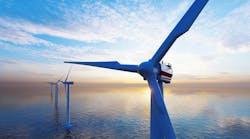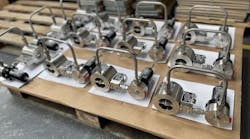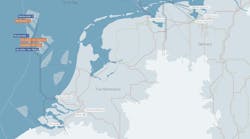Rick Von Flatern
Houston
MWD tools - vibrations and life expectancy
MWD tools, sophisticated and subtle high technology packages working in the decidedly unsophisticated environment at the bottom of a drilling well have always been plagued by vibration-induced failures and deviation. The problem is sufficiently bothersome to MWD tool manufacturers and distributors that most now have "shake and bake" labs where tools bound for the field are subjected to vibrations and elevated temperatures of the environment to which they are being sent.
Solid state electronics, surface mounted circuit boards, instrument mountings that isolate sensitive components from vibration, and the recent availability of BHA vibration modeling computer software, have more than doubled tool life expectancy during the past few years. Now a Houston-based manufacturer of pin-up BHAs, PinTec, has claimed its tool was responsible for a 58-day MWD run in an environment that normally rattles MWDs to failure within an average of 18 days.
The extended run with Anadrill's Slim 1 retrievable MWD tool was the result, according to PinTec vice-president, Rick A. Dudman, of a pin-up configuration that permits use of BHA components one size larger than would normally be possible in slimhole drilling. With the pin facing upward a 5 1/4-in. BHA can be fished from a 6 1/2-in. hole whereas in the same bore hole, a 4 1/2-in. OD tool is the maximum that can be latched in a traditional box up configuration.
The one-size-larger tool is 50% stiffer, limiting both vibration and deviation. PinTec has signed a licensing agreement to supply Anadrill with the altered subs for MWD tool use.
Just an idea for upgrading semis
Finding ways to enable semisubmersible drilling units to work in waters deeper than their designers planned for is as common a topic of conversation in deepwater E & P circles as is the seemingly insatiable demand for the rigs themselves. Converting rigs more cheaply and in less time is especially intriguing to contractors and operators anxious to cash-in on operators' headlong rush to ever deeper waters.
The upgrading process, in its simplest form, is a matter of dealing additional weight and larger mooring systems. The two considerations are tied very closely in that one of the largest contributors of additional weight on a converted rig derives from the new mooring system in the form of more and larger winches, cable, and chain. Though barely in the talking stage, an alternative to the addition of all this new iron has been tossed out by BP's Wim Morris. In the BP in-house publication, Downhole Talk, Morris suggested second generation semis could work in fourth-generation environments using four pre-installed tension leg moorings supported by buoys. Upon arriving on location the rig's current resources would be sufficient to tie it to the deeper set moorings.
Like most new ideas, the realization of Morris's concept is doubtful, even to some deepwater experts within his own company. There are, at first blush, a number of reasons to agree with the naysayers. The cost and practicality of setting anchoring mechanisms permanently in such deep waters is difficult to gauge as it has never been done. Piles driven into the seabed of such depths, for instance is not now feasible, or at least has not yet been done. And the spread on such a mooring system may have to be so wide as to preclude bringing pipelines and risers to the rig.
Still, the idea is not without its attractions and no one is yet saying it is impossible. Beside saving millions on new mooring systems, the lack of new mooring equipment would also result in savings in rig upgrades such as sponsons and topsides enlargement. A particularly attractive added benefit includes the possible reuse of the tension legs to hold a floating production system after the drilling unit has moved off.
As Morris has said, the idea is simply that at the moment - an idea. Perhaps it is one that deserves a hearing.
MWS coming to Gullfaks
Measuring the flow of fluids before separation has apparently moved a step forward with the award of a contract from Statoil to Multi-Fluid International to supply the oil company's Gullfaks Satellite Project with eight of the testing and allocating meters. The award, according to MFI, follows eight years of research into multiphase technology conducted by Norsk Hydro and sponsored by eight international oil companies.
MFI quoted Statoil as saying the elimination of the traditional need to separate produced oil, gas, and water into dedicated separators will result in cost savings of typically 50-500 million NOK per field development. The fluid company believes the figure is low as Statoil did not include in their calculations increased revenues from enhanced reservoir and process management practices made possible by multiphase metering.
The multiphase meters, which use microwave technology and advanced electronics to determine flow rates without separation, will be used for well testing and allocation metering.
Deepwater pipeline blockage investigations
Deepstar, the consortium of 18 major oil companies investigating the technical challenges of deepwater exploration and production, has contracted Houston-based Radoil Tool Co. to develop a standard testing means for removal of wax and hydrate blockages from pipelines farther than five miles from its access point.
At the project's core is construction of a 6-in., 900-ft test pipeline with multiple bends to simulate traversing five miles of pipeline. Starting in the fourth quarter of 1996, following completion of the test pipeline, DeepStar plans to test the ability of manufacturer-offered equipment to navigate pipelines and remove blockages. The consortium is asking manufacturers wishing to offer equipment for testing contact Benton Baugh at Radoil at (713) 937-4494 or at email address 103275,[email protected].
Petronius plans forwarded
Texaco and Marathon Oil have announced plans to move ahead with design and construction of its $400 million Petronius drilling and production project. J. Ray McDermott has received a $140 million construction and installation contract for the 21-well slot, 43,000-ton compliant tower. The production and drilling tower will be in 1,754 ft of water in the Gulf of Mexico Viosca Knoll Block 786 and driven to 450 ft below the mudline. Tower construction is expected to take 18 months with foundation installation slated for sometime in 1997 and tower and topside installation in 1998.
Petronius will have a maximum production rate of 60,000 b/d of oil and 100 MMcfd of gas with first production expected in January 1999. Estimated recoverable reserves for the field 130 miles southeast of New Orleans is 80 - 100 million BOE. With peak water production expected to reach 72,000 b/d the development project calls for seven water injection wells to accompany the 10 planned production wells. A 20-mile long, 14-in. oil pipeline and a 12-mile long, 12-in. gas pipeline will be built to carry production to existing offshore facilities.
Copyright 1996 Offshore. All Rights Reserved.




